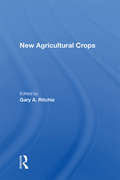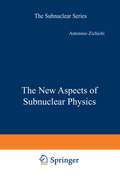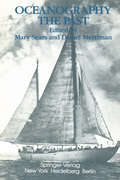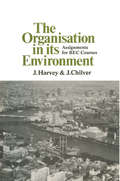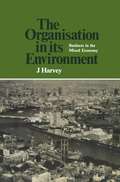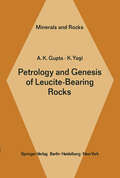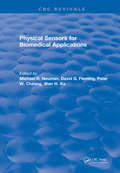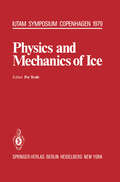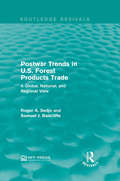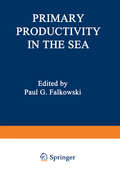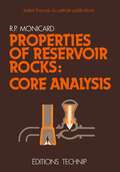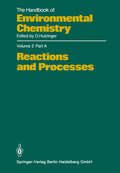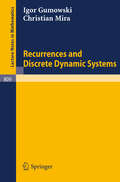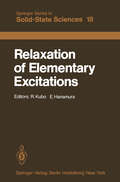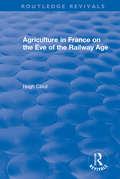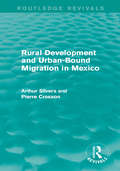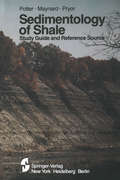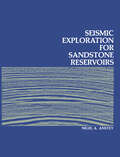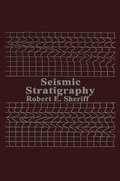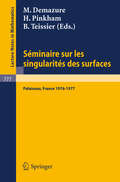- Table View
- List View
New Agricultural Crops
by Gary A RitchieCurrent and projected worldwide shortages of energy, fertilizer, and irrigation water, coupled with a rapidly expanding population, are prompting agricultural scientists to seek, identify, and develop new crop species. Such crops should be energy- and water-efficient, well adapted to marginal lands, suited to intensive culture, and productive of ma
The New Aspects of Subnuclear Physics (The Subnuclear Series)
by Antonio ZichichiIn August 1978 a group of 80 physicists from 51 laboratories of 15 countries met in Erice to attend the 16th Course of the International School of Subnuclear Physics. The countries represented at the School were: Austria, Denmark, Federal Republic of Germany, Finland, France, Israel, Italy, the Netherlands, Sweden, Switzerland, South Africa, Turkey, the United Kingdom, The United States of America, and Yugoslavia. The School was sponsored by the Italian Ministry of Public Education (MPI) , the Italian Ministry of Scientific and Technological Research (MRSI) , the North Atlantic Treaty Organization (NATO), the Sicilian Regional Government, and the Weizmann Institute of Science. As usual, the Course was devoted to a review of the most out standing problems and results in Subnuclear Physics, with particular emphasis on the new aspects; there were mainly two: supersymmetry and electroweak interactions. In his famous lecture at Erice in 1967, Sid Coleman reviewed "All possible symmetries of the S matrix. " All but one, namely that which tells you: if you have a fermion you must have a boson. This is super symmetry , and this produces the superspace, i. e. an entity which has not only the Einstein-"bosonic" coordinates, but also "fermionic" coordinates. From superspace we get supergravity; and this means that one day we should be able to detect not only the graviton (with spin 2) but also the gravitino (spin 3/2). If we add "flavour", "colour", and "family" as other intrinsic degrees of freedom, we get extended supergravity.
Oceanography: Proceedings of the Third International Congress on the History of Oceanography, held September 22-26, 1980 at the Woods Hole Oceanographic Institution, Woods Hole, Massachusetts, USA on the occasion of the Fiftieth Anniversary of the founding of the Institution
by M. Sears D. MerrimanThis volume, "Oceanography: The Past," is the Proceedings of the Third Inter national Congress on the History of Oceanography, organized under the auspices of the Woods Hole Oceanographic Institution at Woods Hole, Massachusetts, USA, September 22-26, 1980. The Congress is a part of the year-long celebration of the Fiftieth Anniversary of the founding of the Woods Hole Oceanographic Institution. It will be followed by an Assembly, September 29 -October 2, in which invited speakers will address the question, ''Will we use the oceans wisely-the next SO years in oceanogra phy?" The papers from the Assembly will also be published by Springer-Verlag as "Oceanography: The Present and Future," a companion volume to this book. The First International Congress on the History of Oceanography was held at the Musee Ocean~graphique in Monaco, December 12-17, 1966. It coincided with the centennial of the beginning of the distinguished career of Prince Albert I as a student and patron of oceanography, for it was in 1866 that he first went to sea-on the armored frigate Tetuan of the Royal Spanish Navy. The results of this Congress were published as 57 papers in the Bulletin de l'Institut Oceanogra phique (special no. 2, vols. 1-3, pp. XLII + 807, 1968).
Petrology and Genesis of Leucite-Bearing Rocks (Minerals, Rocks and Mountains #14)
by A. K. Gupta K. YagiPhysical Sensors for Biomedical Applications
by Michael R. NeumanThe material in this book is based upon a two-day workshop on solid state physical sensors for biomedical applications held in Huron, Ohio, December 8-9, 1977. The individual sections of the book are based upon presentations made by the authors at the workshop. Each presentation was transcribed and given to the authors for revision. Also, transcribed, are the discussions had following each presentation.
Physical Sensors for Biomedical Applications
by Michael R. NeumanThe material in this book is based upon a two-day workshop on solid state physical sensors for biomedical applications held in Huron, Ohio, December 8-9, 1977. The individual sections of the book are based upon presentations made by the authors at the workshop. Each presentation was transcribed and given to the authors for revision. Also, transcribed, are the discussions had following each presentation.
Physics and Mechanics of Ice: Symposium Copenhagen, August 6-10, 1979, Technical University of Denmark (IUTAM Symposia)
by P. TrydePostwar Trends in U.S. Forest Products Trade: A Global, National, and Regional View (Routledge Revivals)
by Roger A. Sedjo Samuel J. RadcliffeBy the end of World War II, the United States had become well integrated into the world markets for forest products. No longer can domestic prices of forest products be viewed as being wholly determined by domestic demand and supply, nor even by North American supply and demand, but must be viewed in a worldwide context. Originally published in 1980, this work provides a comprehensive overview of the nature of global forestry, particularly as it pertains to international trade flows of forest products, and analyses the role of the United States in a global context. This is a valuable resource for any student or researcher interested in environmental studies, global trade relations, and foreign market development.
Postwar Trends in U.S. Forest Products Trade: A Global, National, and Regional View (Routledge Revivals)
by Roger A. Sedjo Samuel J. RadcliffeBy the end of World War II, the United States had become well integrated into the world markets for forest products. No longer can domestic prices of forest products be viewed as being wholly determined by domestic demand and supply, nor even by North American supply and demand, but must be viewed in a worldwide context. Originally published in 1980, this work provides a comprehensive overview of the nature of global forestry, particularly as it pertains to international trade flows of forest products, and analyses the role of the United States in a global context. This is a valuable resource for any student or researcher interested in environmental studies, global trade relations, and foreign market development.
Primary Productivity in the Sea (Environmental Science Research #19)
by Paul FalkowskiPrimary productivity in the sea accounts for ~30% of the total global annual production. Holistic understanding of the factors determining marine productivity requires detailed knowl edge of algal physiology and of hydrodynamics. Traditionally studies of aquatic primary productivity have heen conducted hy workers in two major schools: experimental laboratory biology, and empirical field ecology. Here an attempt was made .to hring together people from both schools to share information and con cepts; each author was charged with reviewing his field of exoer tise. The scope of the Symposium is broad, which we feel is its strength. We gratefully acknowledge financial support from the Depart ment of Energy, the United States Environmental Protection Agency, the National Oceanic and Atmospheric Administration, including the NMFS Northeast Fisheries Center and the MESA New York Bight Project. Thanks are due to Mrs. Margaret Dienes, with out whose editorial skills this volume could not have been pro duced, and to Mrs. Helen Kondratuk as Symposium Coordinator. Finally, we wish to record our indebtedness to Dr. Alexander Hollaender for his tireless efforts and valuable advice in sup porting all aspects of this Symposium.
Quantum Fields — Algebras, Processes: Proceedings of the Symposium Bielefeld Encounters in Physics and Mathematics II: Quantum Fields, Algebras, Processes with the Workshop White Noise Approach to Quantum Dynamics at the Centre for InterdisciplinaryResearch, Bielefeld University, Federal Republic of Germany, December 19, 1978
by L. StreitAre we living in a golden age? It is now more than half a century that Einstein and Heisenberg have given us the theories of relativity and of quantum mechanics, but the great challenge of 20th century science remains unre solved: to assemble these building blocks into a fundamental theory of matter. And yet, for anyone watching the interplay of mathematics and theoretical physics to-day, developing symbiotically through the stimulus of a lively, even essential interdisciplinary dia logue, this is a time of fascination and great satisfaction. It is also a time of gratitude to those who had the courage to in sist that "a rudimentary knowledge of the Latin and Greek alpha bets" was not enough, and tore down the barriers between the disciplines. On the basis of this groundwork there is now so much progress, and, notably, such strengthening of the dia].ogue with phenomenology that - reaching out for The Great Break through - this may indeed turn out to be the golden age.
Reactions and Processes (The Handbook of Environmental Chemistry #2 / 2A)
by G. L. BaughmanEnvironmental Chemistry is a relatively young science. Interest in this subject, however, is growing very rapidly and, although no agreement has been reached as yet about the exact content and limits of this interdisciplinary discipline, there appears to be increasing interest in seeing environmental topics which are based on chemistry embodied in this subject. One of the first objectives of Environmental Chemistry must be the study of the environment and of natural chemical processes which occur in the environment. A major purpose of this series on Environmental Chemistry, therefore, is to present a reasonably uniform view of various aspects of the chemistry of the environ ment and chemical reactions occurring in the environment. The industrial activities of man have given a new dimension to Environ mental Chemistry. We have now synthesized and described over five million chemical compounds and chemical industry produces about hundred and fifty million tons of synthetic chemicals annually. We ship billions of tons of oil per year and through mining operations and other geophysical modifications, large quantities of inorganic and organic materials are released from their natural deposits. Cities and metropolitan areas of up to 15 million inhabitants produce large quantities of waste in relatively small and confined areas. Much of the chemical products and waste products of modern society are released into the environment either during production, storage, transport, use or ultimate disposal. These released materials participate in natural cycles and reactions and frequently lead to interference and disturbance of natural systems.
Recurrences and Discrete Dynamic Systems (Lecture Notes in Mathematics #809)
by Igor Gumowski Christian MiraRelaxation of Elementary Excitations: Proceedings of the Taniguchi International Symposium, Susono-shi, Japan, October 12–16, 1979 (Springer Series in Solid-State Sciences #18)
by R. Kubo E. HanamuraThis is the Proceedings of the Taniguchi International Symposium on "Relaxation of Elementary Excitations" which was held October 12-16,1979, at Susono-shi (at the foot of f1t. Fuji) in Japan. The pleasant atmosphere of the Symposium is evidenced in the picture of the participants shown on the next page. The purpose of the symposium was to provide an opportunity for a limited number of active researchers to meet and to discuss relaxation processes and related phenomena not only of excitons and phonons in solids but also electronic and vibrational excitations in molecules and biological systems. First, the lattice relaxation, i.e., multi-phonon process, associated with electronic excitation, which plays important roles in self-trapping of an exciton and a particle (electron and hole) and also in degradation of semi conductor lasers, is discussed. Second, this lattice relaxation is studied as the intermediate state interaction in the second-order optical responses, i.e., in connection with the competitive behavior of Raman scattering and luminescence. Third, relaxation mechanisms and relaxation constants are by spectroscopic methods as well as by genuine nonlinear optical determined phenomena. Conversely the relaxation is decisive in coherent nonlinear optical phenomena such as laser, superradiance, and optical bistability. Fourth, the role played by relaxation processes is discussed for optical phenomena in macromolecules and biological system such as photosynthesis.
Routledge Revivals: Agriculture in France on the Eve of the Railway Age (Routledge Revivals)
by Hugh CloutFirst published in 1980, this compact and useful book uses the earliest volumes of government-published statistics, and with the aid of computer-generated cartography, transforms the numbers there reported into an arrondissement-by-arrondissement comparative picture of French agriculture in the mid-1830s. Clout reviews problems of rapid population growth, scarcely adequate domestic food supplies and primitive systems of transportation, while attention is drawn to spatial variations in agricultural activity and productivity. Commercial, high-yielding farming was best developed in a northern multi-nuclear region, comprising of Ile-de-France, Normandy and Nord, with smaller foci of commercial orientation along an eastern axis from Alsace to Marseilles and in western areas from the Loire to the middle of the Garonne valley. Clout concludes that the revolutionary promise of national economic unity was far from being realised in the 1830s and was not to be achieved until national systems of transport and education were firmly established later in the nineteenth century.
Routledge Revivals: Agriculture in France on the Eve of the Railway Age (Routledge Revivals)
by Hugh CloutFirst published in 1980, this compact and useful book uses the earliest volumes of government-published statistics, and with the aid of computer-generated cartography, transforms the numbers there reported into an arrondissement-by-arrondissement comparative picture of French agriculture in the mid-1830s. Clout reviews problems of rapid population growth, scarcely adequate domestic food supplies and primitive systems of transportation, while attention is drawn to spatial variations in agricultural activity and productivity. Commercial, high-yielding farming was best developed in a northern multi-nuclear region, comprising of Ile-de-France, Normandy and Nord, with smaller foci of commercial orientation along an eastern axis from Alsace to Marseilles and in western areas from the Loire to the middle of the Garonne valley. Clout concludes that the revolutionary promise of national economic unity was far from being realised in the 1830s and was not to be achieved until national systems of transport and education were firmly established later in the nineteenth century.
Rural Development and Urban-Bound Migration in Mexico (Routledge Revivals)
by Arthur Silvers Pierre CrossonRapid growth of urban populations is a major characteristic of economic development and demographic change in developing countries leading to industrialisation and modernisation of major cities. Originally published in 1980, this study focusses on these issues using Mexico as a case study as well as analysing the risk of over-urbanisation and what the effects will be on cities such as Mexico City. This title will be of interest to students of Environmental studies and Economics.
Rural Development and Urban-Bound Migration in Mexico (Routledge Revivals)
by Arthur Silvers Pierre CrossonRapid growth of urban populations is a major characteristic of economic development and demographic change in developing countries leading to industrialisation and modernisation of major cities. Originally published in 1980, this study focusses on these issues using Mexico as a case study as well as analysing the risk of over-urbanisation and what the effects will be on cities such as Mexico City. This title will be of interest to students of Environmental studies and Economics.
Sedimentology of Shale: Study Guide and Reference Source
by Paul E. Potter J. Barry Maynard Wayne A. PryorWe wrote Sedimentology of Shale primarily because we lacked a handy, reasonably comprehensive source of information and ideas about shales for students in our sedimentology program. It was also our feeling that the time for shales to receive more study had finally arrived. Sedimentology of Shale also seems very timely because today more sedimentologists are interested in shales. Certainly in the last five years the pace of shale research has no ticeably quickened because the role of shales as important sources of oil, gas, heavy metals and as a long understudied part of the earth's geologic his tory has been recognized. Noteworthy developments include the elucida tion of the importance of trace fossils in shales, the discovery of thick sequences of overpressured shales in regions such as the Gulf Coast (which have important implications for hydrocarbon migration and faulting), the ex tension of the principles of metamorphic facies to the realm of low tempera ture diagenesis by study of the organic matter in shales, and shales as ul timate sources for mineral deposits. Accordingly, we decided it was timely to write a book on shales. In one respect, however, ours is an unusual book. Most books in geology are produced after one or two decades of progress have been made in a field and attempt to summarize and evaluate that progress.
Seismic Exploration for Sandstone Reservoirs
by N.A. AnsteyThis text was originally written for use with the videotape program of the same title. Numbered video cassettes correspond to the following chapters of the book: Tape Chapter(s) Tape Chapter(s) 1 1-2. 2. 1 11 3. 4 2 2. 2. 2-2. 3 12 3. 5. 1-3. 5. 2 3 2. 4 13 3. 5. 3 4 2. 5-2. 6 14 3. 5. 4-3. 6. 3 5 2. 7-2. 8 15 3. 7-3. 7. 2 6 3 16 3. 8-4 7 3. 1 17 4. 1 8 3. 2-3. 2. 1 18 4. 2-4. 4 9 3. 2. 2-3. 2. 3 19 5 10 3. 3 Complete information about the videotape program, Seismic Exploration for Sandstone Reservoirs may be obtained from: IHRDC, 137 Newbury St. , Boston, MA 02116, (617) 536-0202. Acknowledgements Thanks are expressed to the authors, companies and professional associations who have allowed the use of their material in the course. The author and publisher are grateful for permission to reproduce material whose copyright belongs as follows: Figures: 2. 4-3 (Widess) SEG; 2. 4-4 (Prescott) Continental Oil Company; 3-1 (Le Blanc) AAPG; 3-2 (MacKenzie) AAPG; 3. 1-1 Seiscom Delta; 3. 1-3 (Schramm et al. ) AAPG; 3. 1-4 (Lamer et al. ) Western Geophysical Company; 3. 2. 2-2 Prakla Seismos; 3. 2. 2-3 (Leung et al. ) Amoco Europe; 3. 2. 2-4 (Newman et al. ) S&A Geophysical; 3. 2. 3-2 Seiscom Delta; 3. 3-1 (Taner) Seiscom Delta; 3.
Seismic Stratigraphy
by R.E. SheriffEvery little wiggle has a meaning all its own. This is our underlying faith, that details of seismic waveshapes can tell us the details of the nature of the earth. But their voices are obscured by many irrelevancies. They speak in a high-noise environment, and we have been able to decipher only a small portion. However, things are looking up: better tech niques are lessening the irrelevancies, and we are learning to read. In exploration of unknown areas, determining the nature of the rocks present is often the difficult aspect. Most of the properties of rocks that can be measured at a distance are not distinctive enough to identify the rock unambiguously. Con ventionally, seismic data are used to determine aspects of the structure. Stratigraphic pictures are inferred from the struc ture, the nature of rocks exposed for examination in the sur rounding area, and regional concepts. Three points make seismic stratigraphy feasible now: (1) we have better data quality, (2) we have begun to sys tematize analysis procedures, and (3) we believe in the geologic significance of waveshape details.
